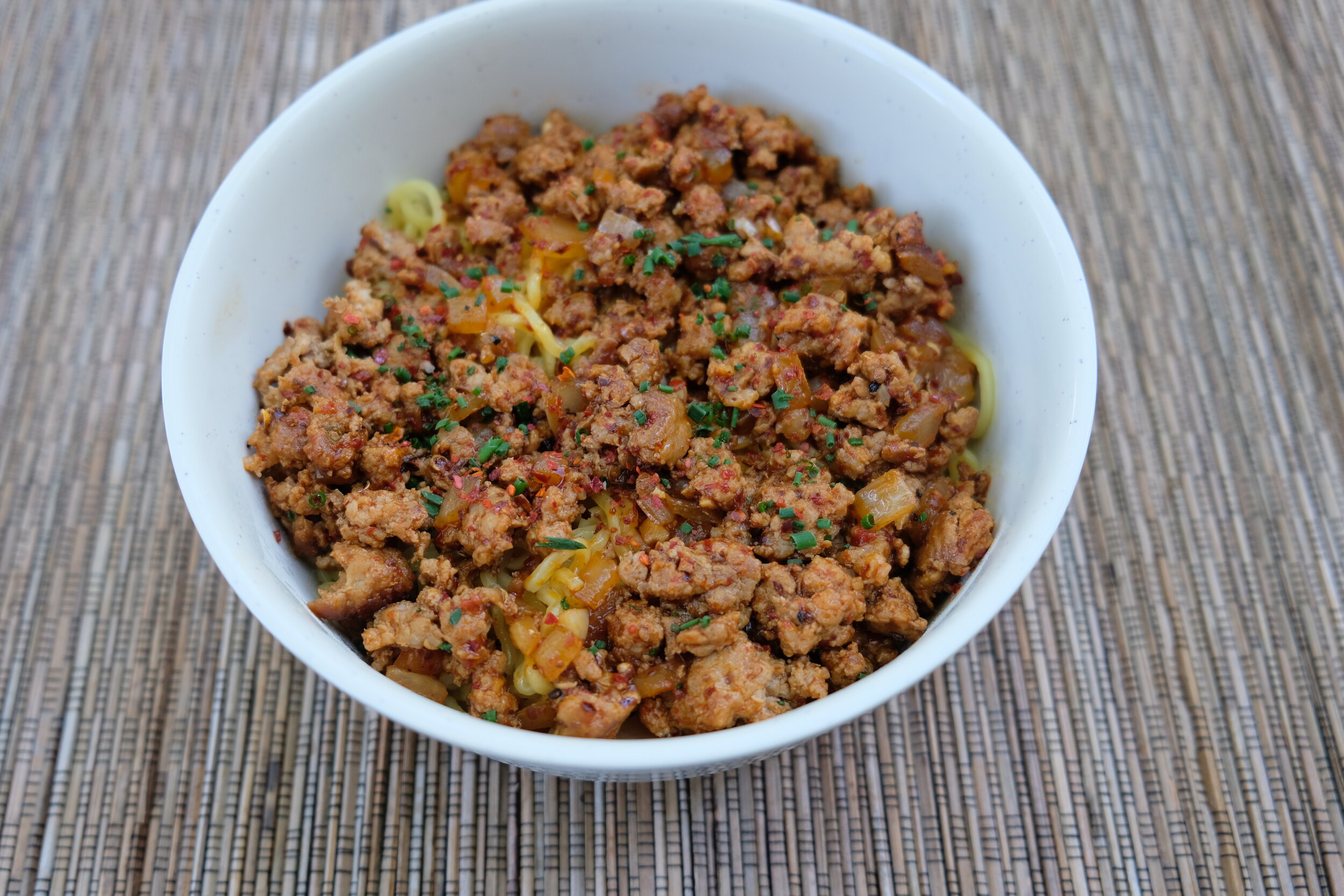Spicy Pork Ragu
*As an Amazon Associate I earn from qualifying purchases.
I am guessing some of you might be wondering about this recipe and if it even belongs here on my blog, as its not a southern inspired dish! However, this recipe is very special to me. Let’s rewind to 2015 when my partner Linsey, who has been my biggest inspiration to cook, gave me my first real cookbook. It was 101 Easy Asian Recipes by Lucky Peach, and it contains a recipe that was the catalyst for this recipe below , as well as many others I have riffed on over the years. Plus, the recipe contains some of my favorite spices, most importantly, Sichuan peppercorns and gochujang . These two ingredients are ALWAYS available in our house, and I add them both to all kinds of dishes (even in a few ones you wouldn’t expect to find them in). Anyone who has met me is likely aware, I am a complete sucker for ramen noodles. This ragu serves as a perfect accompaniment to fresh noodles (you can use dried noodles if you must- but its worth seeking out a decent quality refrigerated noodle from you local Asian grocer or specialty food market).
A little bit about Sichuan peppercorns:
The Sichuan peppercorn is an amazing spice that provides a taste sensation unlike any other spice I know of. It provides spice, but without the heat you get from chili peppers. What you get instead is commonly referred to as a “numbing spice”. Yes, quite literally this spice gives you a numbing or tingling feeling in your mouth when you eat it. I know this sounds really weird but if you haven’t tried it yet, and trust me on this, all it takes is one bite to make you a believer. There are two types of Sichuan peppercorns, a red and green variety. Both are widely available at most Asian grocery stores or online. The red is the more common of the two, and it has a more earthy taste (and it’s what is used in this recipe). The green peppercorn has a more floral and herbaceous flavor profile.
A little more about this recipe:
There is another reason why I am so drawn to this recipe, and that is because of its versatility. If the ramen noodles don’t quite suit your taste, the ragu it goes nicely with rice (that’s what I do with leftovers). If you are in a pinch any other noodle works too. You could even make this as part of a taco or burrito if you are feeling a little daring! But try it this way at least once. You won’t regret it.
Photo by Linsey Sowa
Here is what you need: Feeds 2 plus leftovers
1 lbs ground pork
1 large white or yellow onion, diced
16 oz fresh ramen noodles (I prefer Sun Noodles)
3-4 garlic cloves, minced
1 1/2 teaspoons red Sichuan peppercorns (ground fresh)
1/4 cup water
2 tablespoons soy sauce
2 tablespoons gochujang (reduce to 1 tablespoon if you don’t want it as spicy)
1 tablespoon Korean red pepper flakes, plus more for garnish
1 teaspoon salt
1 teaspoon sugar
Neutral oil for cooking (I use grapeseed or rice bran typically)
thinly sliced scallions or chives for garnish
Let’s make some ragu:
Start by bringing a large pot of water to a boil (I normally tell you to salt the water but for ramen noodles DO NOT salt the water).
Heat a large skillet over medium, once to temp add 2 tablespoons of oil and then add your onions. Continue cooking until translucent. (They may brown slightly which is fine)
Meanwhile in a large bowl add your water, soy sauce, Sichuan peppercorns, gochujang, red pepper flakes, salt, and sugar. Stir to combine, then set aside.
Once the onions are done scoop them from the pan into the bowl with the sauce mixture and fold to incorporate.
Return the pan to the heat, add 1 tablespoon oil and the pork. Break up the pork with a spoon or spatula until almost cooked through.
Push the pork to one side of the pan and tilt the pan slightly to the opposite end so the oil pools in the cleared area. Return the pan to the heat and add your garlic to the pooled oil. Cook the garlic for 1-2 minutes until fragrant, then pull from the heat.
When you add the garlic, quickly drop your ramen noodles into the boiling water until cooked, but still a bit toothsome ( about 2-3 minutes- more if the noodles were dried).
Mix the onions and sauce into the pan with your pork and stir to incorporate.
Pull your noodles from the water, strain, and divide between two bowls. Add a generous helping of the pork ragu over the noodles and garnish with scallions/chives, and Korean Pepper flakes.
ENJOY!
Photo by Linsey Sowa


